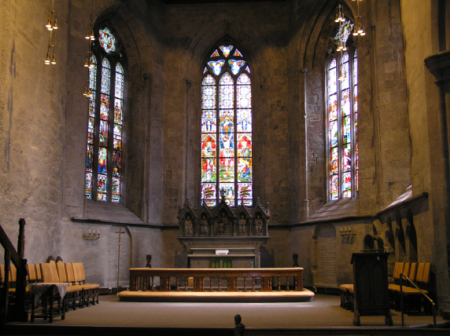The Journey Begins. . .
We arrive in Bergen
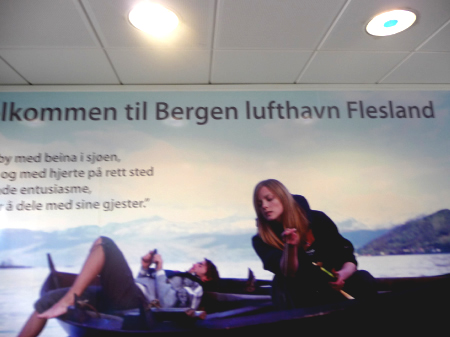 We had signed up for the pre-trip that began in Bergen and traveled through the mountains and fjords to Oslo, where the main tour would assemble. We had flown in the day before the tour was to begin and stayed at the Bergen airport hotel. We had agreed to meet the group flight the next morning for the transfer to town. That morning. . .no Lindblad/National Geographic staff in sight. The passengers on the flight deplaned. . .no visible fellow travelers. We began to consider other options. Finally a young man from the flight approached us and asked if we were with the group. We said we were. "My name is Mike," he said. "I'm a staff member with Linblad and you're not supposed to be here." He showed us his passenger list that indicated we were supposed to meet the group at the downtown hotel. He explained that no one on the pre-trip had booked the pre-arranged flight so he wasn't supposed to meet anyone. Well, the best-laid plans. . . . We were happy that he was alert enough to have seen us and realized what had happened. So we all piled into a taxi and headed for downtown, where Mike made sure our hotel registration was in order and said he would meet us at the reception that evening. We had the rest of the day to ourselves to wander around.
We had signed up for the pre-trip that began in Bergen and traveled through the mountains and fjords to Oslo, where the main tour would assemble. We had flown in the day before the tour was to begin and stayed at the Bergen airport hotel. We had agreed to meet the group flight the next morning for the transfer to town. That morning. . .no Lindblad/National Geographic staff in sight. The passengers on the flight deplaned. . .no visible fellow travelers. We began to consider other options. Finally a young man from the flight approached us and asked if we were with the group. We said we were. "My name is Mike," he said. "I'm a staff member with Linblad and you're not supposed to be here." He showed us his passenger list that indicated we were supposed to meet the group at the downtown hotel. He explained that no one on the pre-trip had booked the pre-arranged flight so he wasn't supposed to meet anyone. Well, the best-laid plans. . . . We were happy that he was alert enough to have seen us and realized what had happened. So we all piled into a taxi and headed for downtown, where Mike made sure our hotel registration was in order and said he would meet us at the reception that evening. We had the rest of the day to ourselves to wander around.
Exploring Bergen
We had two days to explore Bergen, the first on our own and the second with our Norwegian guide, Vivian (who lives in Southern California for the 10 months a year that she isn't leading tours in Norway).
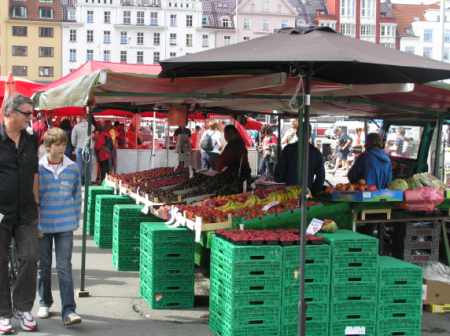 |
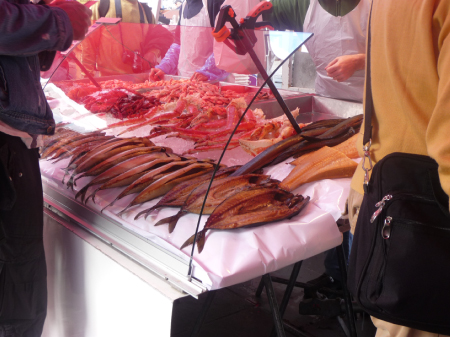 |
Bergen is an old merchant town, a member of the Hanseatic League in the 14th through 17th centuries, and retains that tradition by running an open-air Fish and Flower Market each day--a draw for tourists and for locals seeking fresh fish. |
|
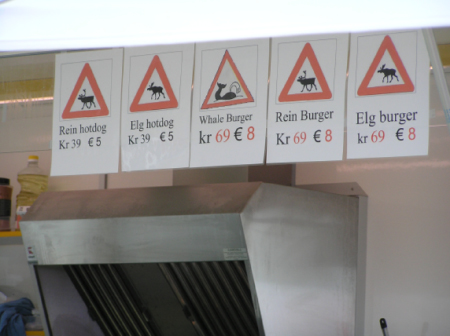 |
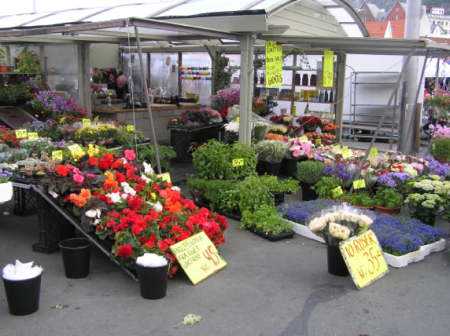 |
Yes, you can buy reindeer and elk hotdogs and burgers and, alas, whale burgers at the Market. |
Although it was the middle of summer, this is the only flower stand that we saw. |
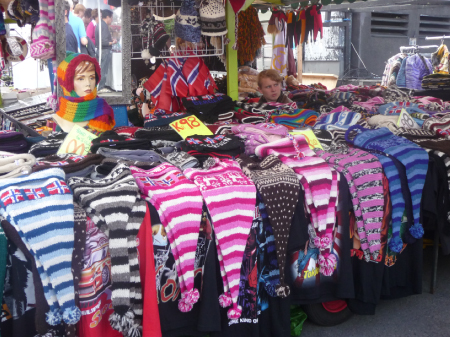 |
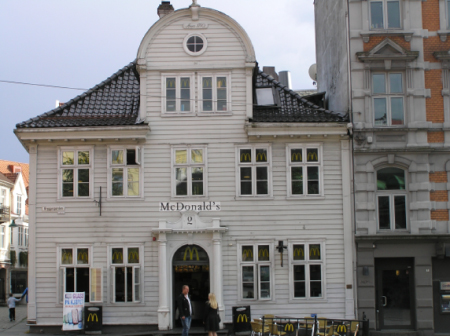 |
| There were, however, lots of stands selling tourist items like hats and sweaters--which were probably not big sellers in the very nice weather we were having. |
And if you don't want fish or other local specialties, there is always the old stand-by, although in a somewhat different shell. |
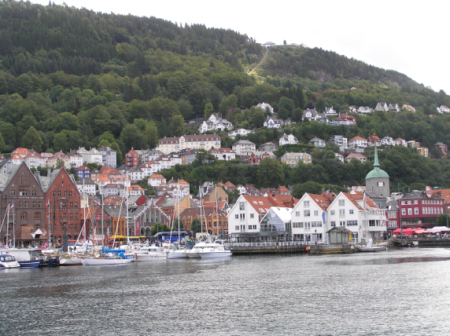 |
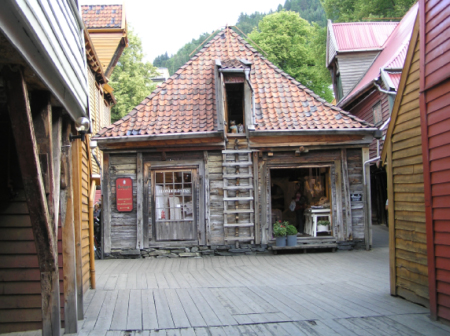 |
| The heart of old Bergen is the Bryggen--the old wharf area. | Built on narrow alleyways, the area has been restored to its 17th-century appearance with shops, warehouses, and living quarters. |
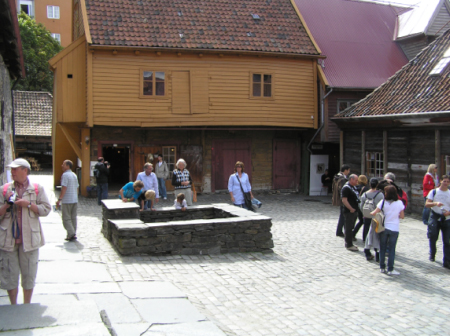 |
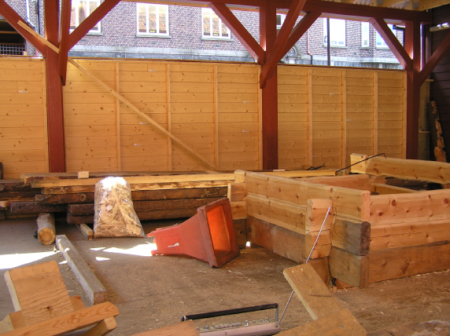 |
| Fire was a constant danger so the complexes included stone patios with fountains near the cooking facilities. | The restoration work is being done as much as possible with period tools and materials. |
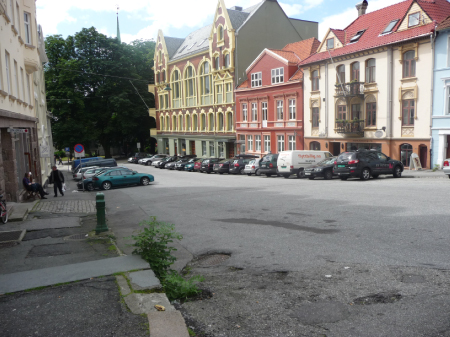 |
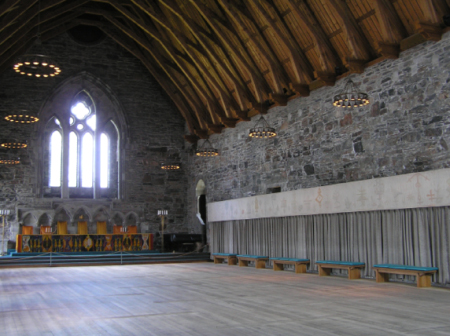 |
| Even the modern streets in the area have an old-fashioned feel. | A point of particular pride with Bergeners is Haakon's Hall, which was totally destroyed in a harbor explosion in WWII (credited to/ blamed on a couple of young anti-Nazi saboteurs) and has been lovingly restored. |
Churches near and far
Norway has a large number of churches, historical and modern. Most are Lutheran (the state religion), although there are other denominations represented as well.
|
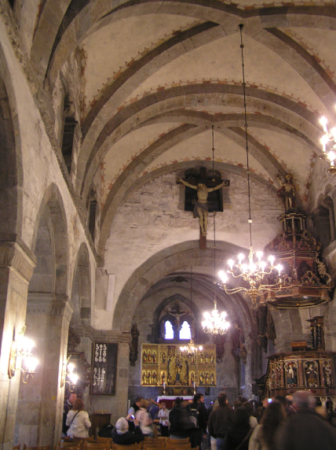 |
|
| The Cathedral Church of Bergen is a lovely example of Gothic architecture. | The Church of St Mary's (which, despite the name, is a Lutheran church) is the oldest in Bergen, built in Romanesque style with added Gothic elements. |
|
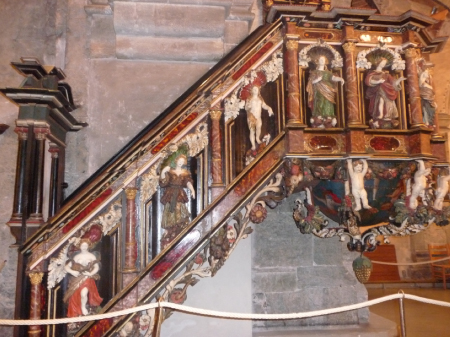 |
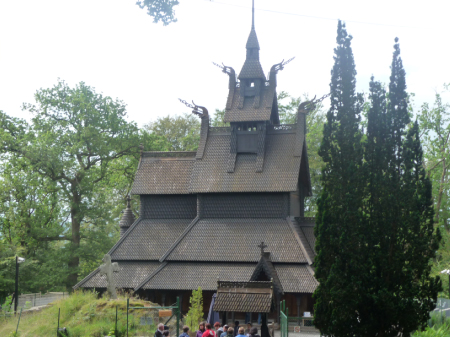 |
|
| The carved pulpit of St. Mary's. | The Fantoft Stave Church is one of a handful of surviving wooden churches built in the time of the Vikings. This one, however, had to be heavily restored/rebuilt after being set alight by a group of Satanists in 1992. |
|
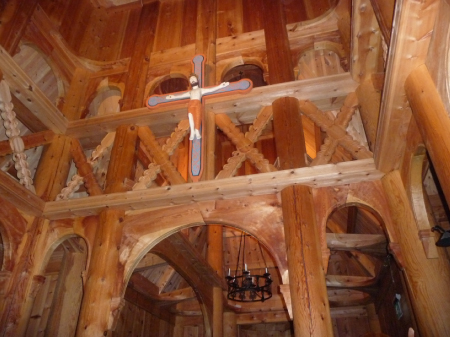 |
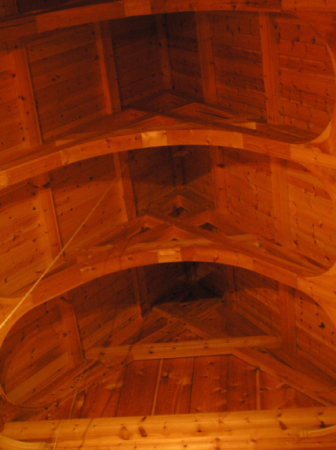 |
|
| The interior of the Church (also a Protestant establishment despite the presence of a crucifix) is built with wooden crosses and X shapes--an engineering necessity but wonderfully symbolic. | Since the Vikings didn't really know how to build large roofed structures but did know how to build ships, the roofs of stave churches are in the shape of upturned boats. | |
A musical interlude
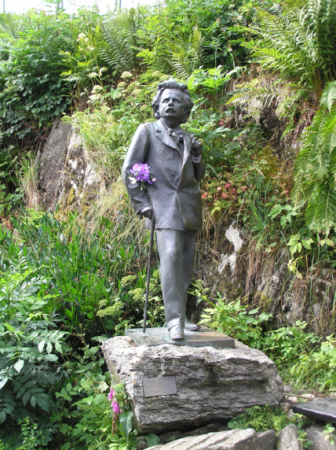 Undoubtedly the most famous residents of Bergen are the composer, Edvard Grieg and his sometimes-collaborator, the playwright Henrik Ibsen. Grieg's estate is now a museum full of social and musical memorabilia.
Undoubtedly the most famous residents of Bergen are the composer, Edvard Grieg and his sometimes-collaborator, the playwright Henrik Ibsen. Grieg's estate is now a museum full of social and musical memorabilia.
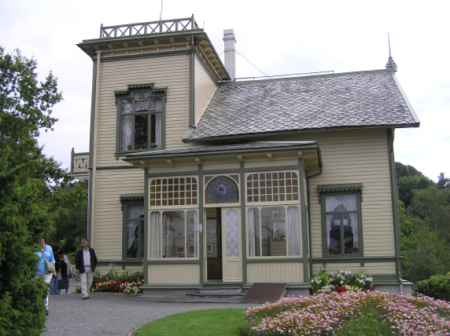 |
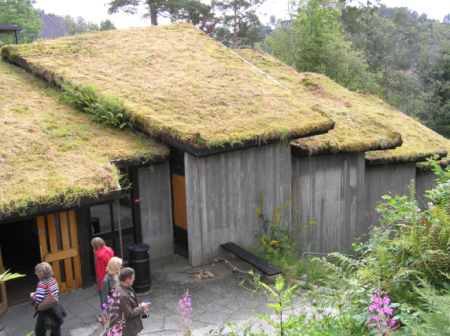 |
| Grieg's house | Concert Hall. Note how it is built into the hillside and the use of a living roof--both characteristic of Norwegian architecture. |
To the top of the funicular
In the center of Bergen there is a funicular that takes you up one of the seven hills (why is it always seven?) along a 26° grade for view of the city. We went in spite of the fact that it was starting to rain.
 |
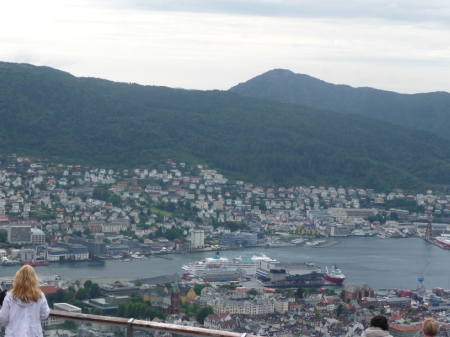 |
| Despite the somewhat inclement weather conditions, the views from the top were quite spectacular. |
|
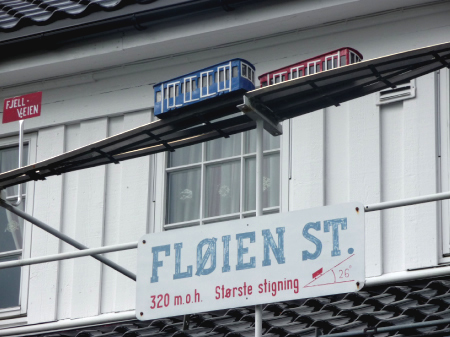 |
|
| At the top station there is a working model of the funicular, with the two cars. They move along the tracks in real time so you can see at a glance if you need to run to catch the next train down. | |
But we were not running for a train--there are lots of hiking trails up the hill and we were going for a walk. Vivian was going to take some people for a short walk, but everyone opted for Mike's longer walk. He objected to Vivian's route as too short and decided to walk up to the end of the trail--supposedly just a couple of kilometers. The map didn't mention the grade. Chuck quit after about a mile, Pat made it to the end of the trail. But then when Mike announced an intention to climb the next hill up to a power station, Pat went back, although a couple of other walkers went with Mike. This was their introduction to a basic rule of the trip: if there is a hill in the vicinity, Mike will climb it.

